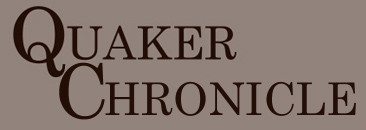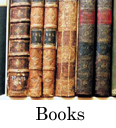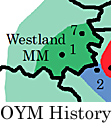The second Westland Meeting House is the earliest meeting house in Ohio YM of which we have any certain information. It was construted in 1785, used for worship until 1869, and demolished in 1885. It stood on the east corner of the intersection of Ridge Road and Dague Road; the latter road is named Hancock Road south of Ridge Road in honor of the Hancock family, some of the final Friends who worshipped at Westland. Earlier accounts have reported that Westland stood a mile east of Centerville, but it actually stood a mile south of Centerville.
Here is a clip of the tax parcel map overlaid onto an aerial that is on the Washington County (Pennsylvania) GIS site, showing the Westland property:

The meeting house stood along Ridge Road, just northeast of the small loop that was part of the historic layout of the property. The first meeting house was built in 1782 on the farm of Joseph Townsend, later men's MM clerk and elder. This first Westland Meeting House burned in 1785, after which the second Westland Meeting House was constructed. Townsend sold the meeting house lot to Westland MM in 1792 (Washington County Deed Q1-355).

The Westland Meeting House was designed with an appearance resembling the Hopewell FMH in Virginia, including its corner chimneys. It had a 1785 datestone plus an unusual inscribed stone in the gable. The unusual stone and the datestone now serve as the base for a historic marker. Note that on the marker, the stone mason ended the meeting in 1864 rather than 1869. Here is the overall historic marker, followed by a detail of the datestone and the unusual stone forming its base.


After the divisions, the Hicksites, Wilburites, and Gurneyites held their worship in the meeting house at specified times so as to not disturb the other branches. The Hicksite and Gurneyite meetings were laid down in 1864, and the Wilburite meeting was laid down in 1869. Thereafter, the meeting house stood vacant for many years.
In 1880, a descendant of the Friends in the area stopped by the meeting house. Its stone walls were covered with overgrowth, but he recorded information about the unusual stone, as captured in this newspaper clipping:

In 1882, two local men (A.J. Cleaver and Joseph Farquhar) wanted to purchase the Westland property to use the grounds as a community burial ground. The Hicksite, Wilburite, and Gurneyite trustees for the property issued separate deeds for the same property, recorded consecutively in Washington County Deed Book W5-465 to 468. It is possible that the ease with which this transaction took place among the three branches precipitated the decision by the Wilburites to sell their interest in the Mount Pleasant Meeting House soon thereafter. The Westland property was transferred to the "Westland Cemetery Association" in 1902 (Washington County Deed 284-513).
The burial ground association demolished the Westland Meeting House in 1885, based on information found in the following newspaper clipping:

In 1938, the granite marker was set up on the site. The mason made an error in the inscription, saying that the meeting was laid down in 1864 rather than 1869. Prior to the unveiling of the marker, some elderly residents of the community (including Mary Hancock Milligan) met with an artist (Charles Noble of Claysville), who painted the only known image of the meeting house based on these recollections. |






